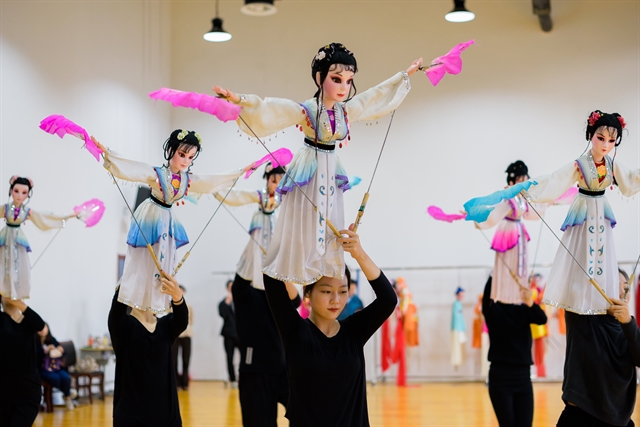 Sunday/Weekend
Sunday/Weekend

Yangzhou puppetry arose in the Tang dynasty, became widely recognised in the Song dynasty and fully developed during the Ming and Qing dynasties. It was famed for the exquisite and lively images of the puppets during performance.

|
| No Title |
Khánh Linh
Yan Yu is 71 years old, but she doesn’t want to retire.
A day in Yu’s life is tightly scheduled. She starts lessons on traditional rod puppetry at 6.30am sharp in the morning, training young people puppetry skills and techniques.
Under her guidance, the students, mostly aged between 16 and 19, practice the art until they are able to master the skills. She only finishes classes at 8.30pm.
Yu has been working as a teacher of rod puppetry – a form of traditional art in China – at the School of Culture and Arts in Jiangsu Province’s Yangzhou City for years. As one of few artists t have mastered the techniques in the province, Yu was afraid the art form, like many others in the world, would one day disappear if no efforts were made to save it.
“Many traditional arts in China have been lost or forgotten for a long time. The reasons are various. The birth of many traditional arts has its unique historical background and regional soil,” Yu told Việt Nam News.
Yu has been trying to pass on her knowledge and cultivate interest in traditional puppetry art among young people in the province.
“But the country and people gave me the strength to grow and move forward and affirmed my professional achievements. My life is approaching dusk, but as far as my energy permits, I will actively do something useful, try to impart my understanding of puppet art and business skills to my students,” she said.
The School of Culture and Arts in Yangzhou City was founded in 1958 and was recently renovated to welcome more students with new large classrooms.
After graduating from secondary school, students will be eligible to register for any type of traditional art they wish to study.
Once accepted, students will be given three years of education free of charge.
The school will provide meals and dorms so that students can concentrate on their studies and reach their full potential.
The preferential policies the school has offered are among huge efforts Yangzhou City is making to promote traditional arts, which have been put at risk of vanishing.
Currently, there are 920 students at the school studying various forms of Chinese culture such as traditional opera and dance, puppetry, and martial arts.
Chinese puppetry has a history of thousands of years and is referred to as the mother of all Chinese theatrical art.

|
| Students practise puppetry performance at the school. — Photo courtesy of China Daily |
Yangzhou puppetry arose in the Tang dynasty, became widely recognised in the Song dynasty and fully developed during the Ming and Qing dynasties. It was famed for the exquisite and lively images of the puppets during performance. Yangzhou rod puppetry is among the three major genres of Chinese puppetry, apart from Quanzhou marionette and Zhangzhou glove puppetry.
It was included on the National List of Intangible Cultural Heritage of China in 2008.
A student of Yu, Liu Zhixuan, told China Daily that she began training puppetry art two years ago when she was 17.
The initial stages of training were quite hard for her as she couldn’t move the puppet the way she wanted to.
“I had been scolded and criticised strictly for failing to manipulate the puppet. The art required precise execution that is only gained by proper and serious training,” she said.
Zhixuan said she loved standing on the stage and the adoration that comes from the audience after a stellar performance.
This year is her last as a rod puppetry student. She plans to become a professional puppeteer after graduation.
For some special art forms that require physical qualities and skills such as dancing, only children at a very early age are welcomed. The kids learn art skills and social studies at the same time. These students will be targeted to join local art troupes.
Keeping traditional values
Since the 1980s, China has enjoyed a phase of rapid economic growth after reforms and opening up, but the development of culture and education has not kept pace.
Many types of culture from around the world can easily enter the country, and young generations have shown little interest in traditional arts, putting them on the verge of disappearing.
To prevent this from happening, the Chinese government has devised strategies to revive dying art forms.
Sun Ping, teacher of the Yangzhou School of Culture and Art, told Việt Nam News that there are nine art schools with the same model in Jiangsu.
All these schools provide a solid background and art skills for students aged under 15.
Ping said students mostly faced the same problem – leaving their families to live at the school.
“They have to learn how to improve their self-care ability and get used to strict requirements on diet catering and intensive and repeated training,” she said.
However, Ping said the biggest concern for students was earning a stable job and decent salaries after they graduated, which the school had a solution for it.
“A recruitment and employment department has been set up to organise the report performance for final-year students, hold a job transaction event and provide talented students to professional troupes.”
“The school will establish a file for each student and track his/her employment development and give timely assistance to them when needed,” she said.

|
| No Title |
“It’s fortunate the government has and is spending great efforts to rescue the arts. It could be said that those of us who stuck to the line of traditional arts and committed ourselves to inheriting traditional arts have finally ushered in the spring,” she said. — VNS